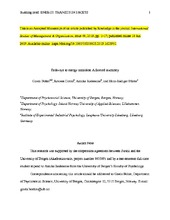Pathways to energy transition: A faceted taxonomy
Peer reviewed, Journal article
Accepted version
Permanent lenke
https://hdl.handle.net/1956/22235Utgivelsesdato
2019Metadata
Vis full innførselSamlinger
Originalversjon
International Studies of Management and Organization. 2019;49(3):303-319 https://doi.org/10.1080/00208825.2019.1623981Sammendrag
The article deals with the public perception of energy transition pathways, that is, of strategies towards sustainable ways of energy use. Implementing sustainable pathways poses a major challenge for organizations and society. Using a facet theoretical approach, we investigate the structure of people’s mental models of such pathways. Three facets are defined capturing the conceptual structure of transition pathways. Facet A (Level) distinguishes three elements: individual behaviors, societal actions, and technologies. Facet B (Type) distinguishes energy efficiency from curtailment pathways. Facet C (Impact domain) distinguishes five domains of potential impact of an energy transition pathway: economy, community, human health, nature, and life quality. A computer-administered survey with items derived from the facet design was administered to a student sample (N = 106). A multidimensional scaling analysis yields regional regularities for Facets A and B. For Facet A polar regions can be clearly distinguished according to the facet elements. Facet B shows regions exhibiting a modular structure with curtailment pathways located in the center and efficiency pathways in the periphery. Facet C shows a less clear pattern, showing the two elements economy and nature at opposing ends of an axial structure. Implications for the communication and management of sustainable energy transitions in society and organizations are discussed.
